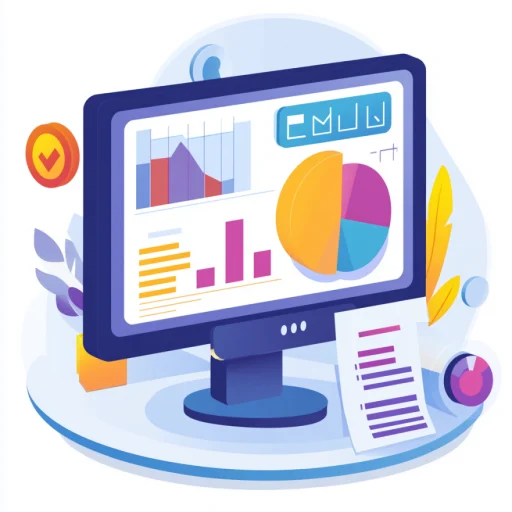In the world of digital marketing, the Microsoft Bing Ads platform (formerly known as Bing Ads) is becoming increasingly attractive to advertisers. Despite Google Ads remaining the market leader, Microsoft offers unique opportunities for businesses that can significantly increase audience reach and reduce customer acquisition costs. In this article, we will explore in detail how to set up and optimize an advertising campaign on Microsoft Bing Ads to achieve maximum results.
By the end of this article, you will learn:
- What Microsoft Bing Ads is and why it’s worth using.
- The types of advertising available on the platform.
- A step-by-step guide to creating an effective advertising campaign.
- Tips for optimization and improving results.
- Answers to frequently asked questions.
What is Microsoft Bing Ads?
History of the Platform
Microsoft Bing Ads was launched in 2009 as a response to Google’s dominance in contextual advertising. Since then, it has evolved significantly, expanding its capabilities and integrations. In 2019, the service was renamed Microsoft Advertising, reflecting its broader versatility and comprehensive approach to advertising.
Today, Microsoft Advertising is a powerful tool that allows advertisers to place ads not only on the Bing search engine but also on partner platforms such as MSN, Outlook, and the Microsoft Audience Network. This makes the platform particularly appealing to companies looking to engage with their target audience across various communication channels.
How Bing Ads Works
Bing Ads operates on the principles of contextual advertising. When a user enters a query into the Bing or Yahoo! search bar, the system analyzes keywords and displays relevant ads. Advertisers pay per click (CPC) or per impression (CPM), making the model transparent and manageable.
The ad display process works as follows:
- User Query: The user enters a query in the search bar.
- Relevance Analysis: The system evaluates the relevance of the query to your ads.
- Auction Participation: If your ad matches the query, it enters the auction.
- Winner Selection: The highest bidder with the best quality score wins.
Key Features of Bing Ads Auctions:
- Quality Score: The higher your ad’s quality score, the lower your cost-per-click may be.
- Bids: You can choose automatic or manual bidding.
- Geotargeting: Target specific regions for ad placement.
Where Are Bing Ads Displayed?
Bing ads are displayed not only on the main search engine but also across numerous partner sites:
- Bing and Yahoo! — Primary search engines.
- MSN — The largest news portal.
- Outlook — Email service.
- Microsoft Audience Network — A network of websites and apps supporting Microsoft ads.
This enables advertisers to reach not only Bing users but also those actively using other Microsoft products. For example:
- MSN users may see ads in news, sports, or technology sections.
- Outlook users receive targeted ads directly in their email inbox.
Advantages of Using Microsoft Bing Ads
- Lower Competition: Fewer advertisers mean lower CPCs.
- Unique Audience: Bing attracts older demographics and professionals, which can be beneficial for certain niches.
- Google Ads Integration: Import existing Google Ads campaigns.
- Analytics Tools: Track and analyze campaign performance.
Types of Microsoft Bing Ads

App Install Ads
This format helps promote mobile applications. Ads are shown to users who frequently use smartphones for searches. It’s especially effective for companies with their own mobile apps for customer engagement.
Example: Promoting a Food Delivery App
If you own a restaurant and want to increase orders via your mobile app, create an ad with an “Install” button. This allows users to quickly download your app and start using your services.
Expanded Text Ads
One of the most popular formats, allowing additional fields such as headlines, descriptions, and links. For instance, you can include extra details like free shipping or warranties.
Tips for Improving Text Ads:
- Use strong calls-to-action (CTAs).
- Include keywords in headlines and descriptions.
- Add extensions like phone numbers, addresses, or reviews.
Responsive Search Ads
Automatically generated based on provided text. Ideal for testing different ad variations. The system analyzes user behavior and selects the most effective combinations of headlines and descriptions.
Example: Selling Electronics
If you sell laptops, create multiple headline and description variations. The system will automatically determine which version performs best for different user groups.
Dynamic Search Ads
Shows ads based on the content of target pages. Useful for large product catalogs. For instance, if you have an online store with thousands of items, dynamic ads automatically generate listings for each category or even individual products.
How to Set Up Dynamic Ads:
- Create a list of target pages.
- Configure keyword matching rules.
- Add ad templates.
Audience Ads
Responsive Audience Ads
Uses user behavior data to create personalized ads. For example, if a user has already visited your site, the system can show them special offers or reminders about abandoned purchases.
Feed-Based Audience Ads
Works with pre-existing contact lists for targeted advertising. Particularly useful for B2B companies with client databases.
Example: Retargeting Existing Customers
If you have a database of past customers, you can show them special offers or promotions. This helps improve loyalty and repeat sales.
Multimedia Ads
Supports banners, videos, and other visual formats. For example, you can create a video showcasing your product’s benefits or use eye-catching banner images.
Tips for Creating Effective Multimedia Ads:
- Use high-quality visuals and videos.
- Add strong CTAs.
- Optimize banner sizes for different devices.
Product Ads
Designed for e-commerce stores. Allows displaying products with images, prices, and descriptions. This helps users quickly find what they need and make purchases.
How to Improve Product Ads:
- Use high-quality product photos.
- Provide detailed descriptions and specifications.
- Offer special deals or discounts.
Vertical Ads
Optimized for mobile devices. Particularly relevant given the growing number of mobile users. Vertical ads take up more screen space and grab attention.
Example: Promoting a Mobile App
To attract new users for your mobile app, create a vertical ad with an engaging image and a strong CTA.
Intelligent Search Ads by Microsoft
Uses artificial intelligence to predict user queries and display relevant ads. For example, if a user frequently searches for health-related information, the system might suggest ads for medical services.
How AI Works:
- Analyzes user behavior.
- Predicts future queries.
- Displays the most relevant ads.
How to Set Up a Microsoft Bing Ads Campaign

Step 1: Create a Microsoft Advertising Account
Start by registering on the official Microsoft Advertising website. The process is straightforward:
- Fill out the registration form with your business details.
- Confirm your email address.
- Configure account settings.
It’s important to provide accurate business information so the system can classify your company correctly.
Tips for Successful Registration:
- Use a corporate email.
- Specify the correct business location.
- Upload necessary documents for verification.
Step 2: Import Existing Google Ads Campaigns (Optional)
If you already have successful Google Ads campaigns, you can easily import them into Microsoft Advertising. This saves time during setup. However, ensure that keywords and landing pages align properly, as Bing and Google audiences may differ.
How to Import a Campaign:
- Log in to your Microsoft Advertising account.
- Navigate to the “Import” section.
- Select your Google Ads campaign file.
- Adjust necessary settings.
Step 3: Choose the Right Keywords
Keywords are the foundation of any ad campaign. Use tools like Keyword Planner to research relevant queries. For example, if you sell computers, start with general terms like “buy computer” and then refine with more specific ones like “buy gaming computer.”
How to Find the Right Keywords:
- Use competitor analysis tools.
- Explore long-tail keywords.
- Check seasonal trends.
Step 4: Create Your First Campaign

A. Click “Create Campaign”
On the main dashboard, select “Create Campaign.” Here, choose the type of campaign: search, display, or audience.
B. Select Your Campaign Goal
Goals can vary from increasing sales to generating leads. For example, if you aim to attract new customers, choose the “lead generation” goal.
C. Enter Business Information
Add your company name, website URL, and contact details. Ensure all fields are filled out accurately, as this affects user trust.
D. Choose Relevant Keywords
Use exact and broad match options for different ad groups. For example, use precise queries for exact matches and broader terms for wider targeting.
E. Create Your First Ad
Write an appealing headline, description, and add links. For instance, your headline could read “Buy a Computer with 20% Off.” The description should highlight key advantages of your offer.
F. Configure Additional Settings (Optional)
Add ad extensions such as phone numbers, addresses, or reviews. This improves conversion rates.
G. Set Your Budget
Choose a daily or total budget for your campaign. For example, if your budget is $100 per day, the system will distribute spending throughout the day.
Step 5: Track Your Results
Use built-in analytics tools to monitor metrics like CTR, conversions, and ROI. For example, if one ad shows high CTR but low conversion rates, try optimizing the landing page.
How to Improve Campaign Performance:
- Regularly analyze data.
- Optimize bids and budgets.
- Test different ad variations.
7 Tips for Optimizing Microsoft Bing Ads
Tip 1: Thoroughly Research Keywords
Explore both primary and long-tail queries. For example, if you sell coffee, consider terms like “best coffee for home” or “office coffee.”
How to Find Long-Tail Keywords:
- Use competitor analysis tools.
- Explore forums and social media.
- Check autocomplete suggestions in search engines.
Tip 2: Get to Know Your Audience Better
Analyze demographic data, interests, and user behavior. For example, if your customers are primarily in the U.S., set geotargeting specifically for that country.
How to Analyze Your Audience:
- Use Bing Ads analytics tools.
- Review user behavior on your website.
- Conduct surveys among customers.
Tip 3: Import High-Performing Google Ads Campaigns
If your Google Ads campaigns perform well, use them as a starting point for Bing Ads. Remember, audiences may differ, so adapt strategies accordingly.
How to Adapt Campaigns:
- Modify keywords for Bing’s audience.
- Update landing pages.
- Run tests.
Tip 4: Use A/B Testing
Run experiments with different ad variations to find the most effective option. For example, compare two headlines: “Buy Coffee Online” and “Best Coffee for Home.” This helps identify which version performs better.
How to Conduct A/B Testing:
Analyze results.
Create two ad variations.
Split traffic between them.
Tip 5: Use the UET Tag
The UET (Universal Event Tracking) tag tracks user actions on your site after clicking an ad. For example, you can track how many users add items to their cart or complete purchases.
How to Set Up the UET Tag:
Start tracking events.
Create the tag in the Bing Ads interface.
Insert the code onto target pages.
Tip 6: Monitor Your Quality Score
A high quality score reduces CPC and increases ad visibility. Ensure your ads and landing pages are highly relevant to selected keywords.
How to Improve Quality Score:
- Optimize headlines and descriptions.
- Enhance landing pages.
- Increase site loading speed.
Tip 7: Optimize Targeting
How to Set Up Targeting in Microsoft:
Use geographic, demographic, and behavioral targeting for better segmentation. For example, if you sell children’s toys, target parents with kids.
Example: B2B Targeting
If you work with other businesses, target professionals in specific industries. For instance, if you sell software for lawyers, target employees at law firms.
Technical Features of Microsoft Bing Ads
Display Ads
Supports various banner and video formats for placement on partner sites. For example, you can create a 300×250 pixel banner for news websites.
How to Choose the Right Format:
- Use standard sizes for maximum compatibility.
- Optimize images for fast loading.
- Add animations to grab attention.
Native Ads
MSN Ads
Integrates with the MSN news portal for maximum reach. For example, if you sell financial services, your ads may appear in the “Business” section.
Outlook Ads
Allows placing ads within the email service. This is especially effective for B2B companies, as many professionals use Outlook for work.
Microsoft Audience Network
Combines multiple websites and apps for comprehensive coverage. For example, if you sell electronics, your ads may appear on tech-focused sites.
Video Ads
Supports pre-roll, mid-roll, and post-roll formats for video content. For example, you can create a 15-second video to play before the main content.
How to Create Effective Videos:
- Use high-quality footage.
- Add subtitles for accessibility.
- Include a strong CTA.
Frequently Asked Questions (FAQ)
Can I Use Microsoft Bing Ads for My Online Retail Store?
Yes, the platform is ideal for e-commerce stores thanks to specialized product ad formats. For example, you can display product cards with images, prices, and descriptions.
Can I Import My Existing Google Ads Campaigns into Microsoft Bing Ads?
Yes, the import feature is available in the Microsoft Advertising interface. However, it’s crucial to adapt campaigns to Bing’s specifics.
Can I Track the Effectiveness of My Microsoft Bing Ads Campaigns Using Conversion Tracking?
Yes, use the UET tag to set up tracking. For example, you can track the number of completed orders or subscriptions.
How Much Does Microsoft (Bing) Advertising Cost?
Pricing depends on keyword competitiveness and bidding strategy. For example, if you use automatic bidding, the system will determine the optimal cost-per-click.
In Which Countries Does Microsoft Bing Operate?
Bing is available in nearly all countries worldwide. However, keep in mind that Bing’s audience may differ from Google’s depending on the region.
Comparison: Google Ads vs. Microsoft Bing Ads
Pros and Cons of Each Platform
| FACTOR | GOOGLE ADS | MICROSOFT BING ADS |
|---|---|---|
| Competition | High | Low |
| Audience Reach | Large | Unique |
| Cost Per Click | High | Low |
| Analytics Tools | Diverse | Simple |
Who Should Use Bing Ads?
For businesses targeting older demographics and professionals. For example, if you sell accounting services, Bing may be a more effective platform.
Who Should Use Google Ads?
For companies aiming to reach the widest possible audience. For example, if you sell mass-market consumer goods, Google can provide greater reach.
Conclusion
Microsoft Bing Ads is a powerful tool offering unique opportunities for advertisers. Thanks to lower competition and high efficiency, this platform is becoming increasingly popular among marketers. Start using Bing Ads today to expand your reach and reduce customer acquisition costs!


Leave a Reply